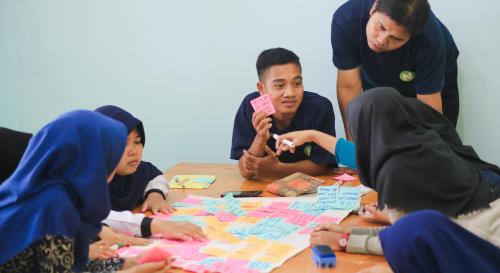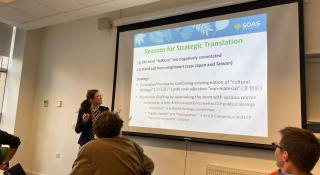
Breadcrumbs navigation
Designing a course with your students as an early-career teacher: Collaborative pedagogy in times of precarity
Zoë Jay was joint winner of the 2023 Award for Early Career Excellence in Teaching International Studies. In her module, Zoë invites her students to help shape what they learn and shows us the benefits in trusting our students.
The types of teaching and learning I am interested in – collaborative, critical, curious, and most importantly, grounded in practices of kindness and solidarity – face a time problem. “Those are lovely ideas”, I am told as I wait for the caveat, “but I don’t have the time [or energy or job security or institutional power] to do something like that.” The people who say this aren’t wrong. Those of us who have cut our teeth as teachers in the most recent years of the neoliberal university system know all too well the struggles of balancing teaching well with preparing quickly, squeezing the methods and activities we want to use into the ever-tighter constraints of curriculum approvals, assessment metrics, and universities’ refusal to pay us properly for core duties such as lecture planning and marking.
So I want to share how my students and I use collaborative course design to study critical approaches to human rights in Europe, but I want to do so by putting collaborative teaching practice in the context of the precarious and exploitative employment situations that I and most of my early-career colleagues are in as teachers. I have had a fair degree of teaching autonomy at the University of Helsinki for the last few years, but the vast majority of my university teaching career has been on casual hourly contracts, routinely and severely underpaid, and with little to no influence over the course content or policies relating to things like extensions and attendance.
It is important that you know that about me because, as bell hooks writes, teaching is not a set of "neutral" tips and techniques that transfer neatly from one classroom to the next. Rather, knowledge and learning “emerge from bodies”, and to participate in a classroom is “to offer something of ourselves.” What I offer of myself here is an awareness (often stubbornly, reluctantly acquired) that everything I do as a teacher, every single element of my practice, is some sort of compromise or workaround between what I want to do in keeping with leading scholarship in critical pedagogy, and what I am able to do, in terms of the paid time, decision-making power, and emotional energy I have in a given context. This piece is a reflection on how collaborative pedagogy has helped me to navigate the dance of compromise and, sometimes, to minimise the worst excesses of university bureaucracy and precarity.
The plan: Implementing a collaborative course design
In our Masters-level course, ‘The Politics of European Human Rights’, students and I decided together how to approach the course. I provided a preliminary course outline with guidance and suggestions, which we finalised in the second week of term. The students voted on some of the lecture topics, and we made decisions together about things like what kind of assessment feedback they would find most helpful, and how we would relate to each other in the classroom. We agreed, for example, that we would alternate between calling on in-class and online students to ensure the hybrid format was always balanced. Based on students’ interest in situating regional European human rights discourses in a broader global context, we also added a lecture to the schedule comparing the rights of minority and Indigenous communities in Finland, China and Australia.
The Challenges: Time and Autonomy
Our experience of designing and implementing the course collaboratively was so rewarding that some of the students and I are continuing the collaboration by co-authoring a journal article together (stay tuned!). But collaborative course design is notorious for being a highly time-intensive method, albeit one that teachers usually say is worth the effort. Giving students the opportunity to choose their own reading lists or design assessment tasks, as US-based teachers Amy Nelson and Afshan Jafar have done, means teachers have to adapt to new material at short notice, or mark and provide feedback on something less familiar than a well-worn essay question.
"Our experience of designing and implementing the course collaboratively was so rewarding that some of the students and I are continuing the collaboration by co-authoring a journal article together".
I navigated these time-management challenges in a few ways. First, I chose to retain control over assessment design and invited students to choose some of the course content from a list of topics I knew I could already teach. My student co-authors tell me they preferred this to an open choice because it allowed them to pick topics they otherwise didn’t know about (like prisoners’ rights and abolition) and because it meant they did not have the time pressure of having to do additional research to find suitable topics and readings either.
Second, as part of our expectations discussion, I told the class I would grant extensions to anyone who asked for them without question and I wouldn’t take attendance. These are an important part of the collaborative environment because they show students I trust them to manage their own time and lives. I also do it because it saves me an enormous amount of time in emails. In short, students don’t have to perform their illnesses or financial situations to me, and I don’t have to agonise over whether the performance is 'good enough' to 'deserve' an extension.
Finally, collaboration can, in some forms, require a lot of institutional autonomy that precariously employed teachers or early career teachers contributing to someone else’s course don’t always have. I am lucky to have enough free-rein in ‘Politics of European Human Rights’ to do a whole-course collaboration and to publish with my students. But I knew collaboration on this scale would work because even when I was a tutor teaching other people’s courses, the students and I would discuss how they would like to approach the content provided, and what kinds of feedback would be most useful for them while still fitting in the very limited time I had to read and mark their essays.
The takeaway: Collaborative dreams for precarious (non-)teens
We should not have to try to squeeze our good teaching practice into precarious and exploitative work conditions. But since we do (for now at least), I want to focus my energy towards the people in academia that I care about most – my students – and to resist as much as possible the competitive expectations and rules of the institution itself. There are many things we do not have control over as early career, precarious teachers, but what we do have control over is how we relate to and communicate with our students when we’re in the room with them. The beauty of collaborative teaching is that it is a continual, relational practice, flexible enough to be adapted to our and our students’ conditions. Rather than focusing on any particular activity, collaboration is about trusting our students and communicating honestly with them about what we can or cannot do together.
"Giving students these opportunities is a wonderful approach to teaching that encourages students engagement, participation, and ownership in their education, and in a way that is so much more powerful than simply having our students complete pre-determined assignments".



